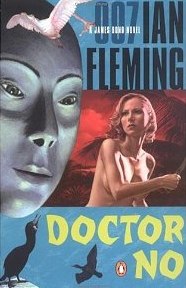Dr. No
by Ian Fleming
It’s hard to remember that this was (in 1958) new, that Sean Connery was not yet the real James Bond. I suppose the real James Bond was Peter Fleming, Ian’s big brother.
Roger was walking along Gower Street. He had passed the School of Tropical Hygiene. He had passed the Royal Academy of Dramatic Art. In one minute, in less than one minute, he would have reached the Slade.... so I called across the street: "Roger, come to Brazil."
"What?" said Roger: playing, I dare say, for time.
"You’d better come to Brazil” I said, getting into a car.
“Why?” said Roger cautiously (or perhaps incautiously), also getting into the car. We set down Gower Street: past the Royal Academy of Dramatic Art: past the School of Tropical Hygiene. I talked rapidly. At the end of Gower Street Roger got out.
“I'll let you know for certain on Monday,” he said.
The book has superficial faults. The casual racism can be forgiven, the way we excuse Dickens and Dorothy Sayers, though by 1958 Fleming might have known better, and – considering this is James Bond – the sexism is not as bad as we might fear. I’m less sanguine about the concluding action sequence, which seems to take a very long time to accomplish very little.
Bond’s concept of a workout – he employs a personal trainer to get in shape for the mission – is quaint: 3 1-mile jogs interspersed with hours of sunbathing is considered a real workout. It’s also striking how much richer the rich have grown since 1958; the fantastic Dr. No has a palace/control center that’s not much nicer than a large law firm’s offices, its walls are adorned with lithographs and reproductions, and Bond thinks the appropriate bribe to offer a henchman to betray the operation is $10,000 and an airplane ticket.
